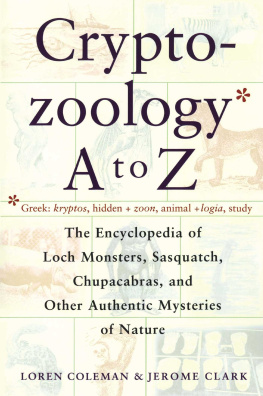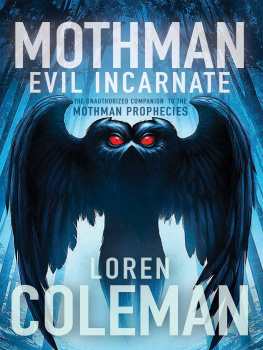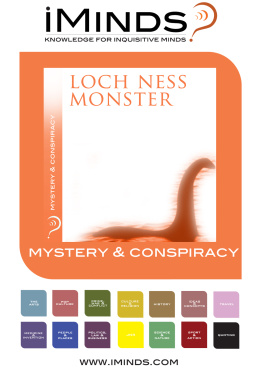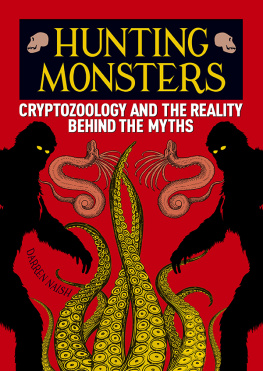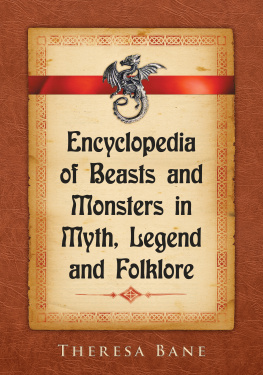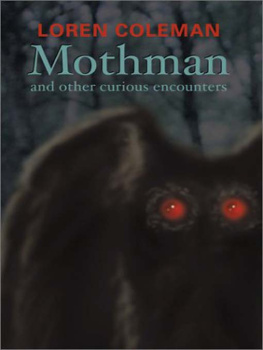Loren Coleman - Cryptozoology A To Z: The Encyclopedia of Loch Monsters, Sasquatch, Chupacabras, and Other Authentic Mysteries of Nature
Here you can read online Loren Coleman - Cryptozoology A To Z: The Encyclopedia of Loch Monsters, Sasquatch, Chupacabras, and Other Authentic Mysteries of Nature full text of the book (entire story) in english for free. Download pdf and epub, get meaning, cover and reviews about this ebook. year: 0, genre: Detective and thriller. Description of the work, (preface) as well as reviews are available. Best literature library LitArk.com created for fans of good reading and offers a wide selection of genres:
Romance novel
Science fiction
Adventure
Detective
Science
History
Home and family
Prose
Art
Politics
Computer
Non-fiction
Religion
Business
Children
Humor
Choose a favorite category and find really read worthwhile books. Enjoy immersion in the world of imagination, feel the emotions of the characters or learn something new for yourself, make an fascinating discovery.
- Book:Cryptozoology A To Z: The Encyclopedia of Loch Monsters, Sasquatch, Chupacabras, and Other Authentic Mysteries of Nature
- Author:
- Genre:
- Year:0
- Rating:5 / 5
- Favourites:Add to favourites
- Your mark:
- 100
- 1
- 2
- 3
- 4
- 5
Cryptozoology A To Z: The Encyclopedia of Loch Monsters, Sasquatch, Chupacabras, and Other Authentic Mysteries of Nature: summary, description and annotation
We offer to read an annotation, description, summary or preface (depends on what the author of the book "Cryptozoology A To Z: The Encyclopedia of Loch Monsters, Sasquatch, Chupacabras, and Other Authentic Mysteries of Nature" wrote himself). If you haven't found the necessary information about the book — write in the comments, we will try to find it.
Loren Coleman: author's other books
Who wrote Cryptozoology A To Z: The Encyclopedia of Loch Monsters, Sasquatch, Chupacabras, and Other Authentic Mysteries of Nature? Find out the surname, the name of the author of the book and a list of all author's works by series.
Cryptozoology A To Z: The Encyclopedia of Loch Monsters, Sasquatch, Chupacabras, and Other Authentic Mysteries of Nature — read online for free the complete book (whole text) full work
Below is the text of the book, divided by pages. System saving the place of the last page read, allows you to conveniently read the book "Cryptozoology A To Z: The Encyclopedia of Loch Monsters, Sasquatch, Chupacabras, and Other Authentic Mysteries of Nature" online for free, without having to search again every time where you left off. Put a bookmark, and you can go to the page where you finished reading at any time.
Font size:
Interval:
Bookmark:
Crypto-zoology*
A to Z
* Greek: kryptos , hidden + zoon , animal + logia , study
The Encyclopedia of Loch Monsters, Sasquatch, Chupacabras, and Other Authentic Mysteries of Nature
Loren Coleman & Jerome Clark
For C aleb and M alcolm ,
new explorers of the wild country
For Alex , Evan , and Molly ,
who will be there
when the next century learns
what we don't know now
Cryptozoological research should be actuated by two
major forces: patience and passion.
DR. BERNARD HEUVELMANS, 1988
The word cryptozoology first appeared in print in 1959, when Lucien Blancou dedicated his new book to Bernard Heuvelmans, master of cryptozoology. Four years earlier, when Heuvelmans first published On the Track of Unknown Animals, the term cryptozoology as such did not exist. It was not until the publication of On the Track of Unknown Animals and the sensation it created that Heuvelmans began to call his lifelong pursuit cryptozoology, and a new discipline was born. Since then it has become part of modern vocabulary, and appears in nearly all standard dictionaries.
But what exactly is cryptozoology? It is not, Heuvelmans insists, an arcane or occult zoology. It fuses three Greek words: kryptos, zoon, and logos, which mean, respectively, hidden, animal, and discourse. Thus cryptozoology is the science of hidden animals. Heuvelmans prefers hidden to unknown because to those people who live near them, the animals are not unfamiliar; if they were, there would be no native accounts, and we would never have heard of them. They are, however, undetected by those who would formally recognize their existence and catalogue them.
In 1982, when the International Society of Cryptozoology (ISC) was founded at a meeting held at the Smithsonian Institution, an effort was made to produce a sharper, clearer definition. Cryptozoology, the assembled scientists and investigators agreed, also concerns the possible existence of known animals in areas where they were not supposed to occur (either now or in the past), as well as the unknown persistence of presumed extinct animals to the present time or to the recent past What makes an animal of interest to cryptozoology is that it is unexpected. This further definition failed to address one crucial aspect: the minimum size. In subsequent reflection on the subject, Heuvelmans insisted that a minimum size is essential, though he left the precise dimensions open to further discussion. Nonetheless, he wrote, for an animal (or alleged animal) to be of cryptozoological interest, it must have at least one trait truly singular, unexpected, paradoxical, striking, emotionally upsetting, and thus capable of mystification.
To most persons familiar with the term, cryptozoology is seen as the study of such spectacular and disputed creatures as Sasquatch, the Yeti, and the Loch Ness Monster. These legendary beasts do interest cryptozoologists, but such cryptids (as cryptozoologists call them) comprise only a fraction of the hidden, uncatalogued, or out-of-place animals that have intrigued and frustrated cryptozoologists before cryptozoology as such existed.
Writing in 1988 in Cryptozoology (Vol. 7), Heuvelmans underscored the aims of cryptozoology:
Hidden animals, with which cryptozoology is concerned, are by definition very incompletely known. To gain more credence, they have to be documented as carefully and exhaustively as possible by a search through the most diverse fields of knowledge. Cryptozoological research thus requires not only a thorough grasp of most of the zoological sciences, including, of course, physical anthropology, but also a certain training in such extraneous branches of knowledge as mythology, linguistics, archaeology and history. It will consequen tl y be conducted more extensively in libraries, newspaper morgues, regional archives, museums, art galleries, laboratories, and zoological parks rather than in the field!
CUVIERS RASH DICTUM
In 1812 Baron Georges Cuvier, the revered French biologist considered the father of paleontology, declared the end of the age of zoological discovery. There is, he said, little hope of discovering new species of large animals. From now on, he continued, naturalists ought to focus their attention on extinct fauna. As for fabled creatures such as Sea Serpents, which some of his colleagues held to merit further investigation, Cuvier had these words: I hope nobody will ever seriously look for them in nature; one could as well search for the animals of Daniel or for the beast of the Apocalypse.
In 1819, a mere seven years later, the American tapir was found, only the first of thousands of new animals to be uncovered in the past two centuries. They include the giant squid (1870s), okapi (1901), the Komodo dragon (1912), the kouprey (1937), and the ultimate living fossil, the coelacanth (1938). The largest land mammal to be documented since the kouprey is the extraordinary saola ( Pseudoryx nghetinhensis ), a new bovine species. Since the startling discovery in 1992 of a lost world of animals stretching sixty-five square miles near the Laotian border, Vietnams Vu Quang Nature Reserve has produced evidence of two previously unknown bird species, at least one new fish, an unknown tortoise with a striking yellow shell, and two other mammals besides the Vu Quang ox.
The giant panda of Tibet was often cited during the 1950s and 1960s to demonstrate how a large animal could remain elusive and unknown in montane habitats not unlike some valleys of the Himalayas. Cryptozoologists note that it took sixty-seven years from the time of the giant pandas discovery until its live capture.
There is yet another example, especially germane to the ongoing hunt for uncatalogued large primates. Though the lowland gorilla was officially recognized in 1840, the mountain gorilla eluded detection, considerable searching notwithstanding, until the twentieth century. Indeed, not until 1860 were the first native tales collected of a monster ape said to live on the misty heights of the Virunga volcanoes of East Africa. But to Western zoologists these were no more than unconfirmed anecdotes until October 1902, when Belgian army captain Oscar von Beringe and a companion killed two gorillas on the Virungas Mount Sabinio, thereby removing the animals from the realm of mythology and into a secure place among the worlds recognized fauna. New primates have continued to turn up at an astounding pace throughout the twentieth century. Besides the mountain gorilla, two other apes, the dwarf siamang and pygmy chimpanzee, close relatives of humans and the hominoids* described in this encyclopedia, have been found.
* The word hominid refers to members of the family of humans, Hominidae , which consists of all species on our side of the last common ancestor of humans and living apes. Hominids are included in the superfamily of all apes, the Hominoidea , the members of which are called hominoids. Members of the family of apes, Pongiade are also hominoids, but not hominids. Apes and humans are hominoids. The close-to-human hominids are, for example, the Marked Hominids, the classic Bigfoot, and Neandertals. Cryptids such as Napes, Skunk Apes, and more ape-like animals are included in the broader term hominoidswhich then, of course, encompasses the hominids. All hominids are hominoids, but all hominoids are not hominids.
As Cuviers rash dictum (Heuvelmanss phrase) has been destroyed, the modern world of zoology, of which cryptozoology is a small subdiscipline, continues to be startled as new animals keep getting found. It is safe to say that in its essence, cryptozoology represents a throwback to the way original zoological study was conducted. In the beginning, as explorers trekked to new lands and listened to local informants, they were led to remarkable new species. These animals would then be killed or captured, shipped back to the zoological societies and parks of Europe, and formally classified. Today, with the addition of DNA testing and telebiological techniques, cryptozoology keeps alive the tradition of discovery and recognition of new species of animals.
Next pageFont size:
Interval:
Bookmark:
Similar books «Cryptozoology A To Z: The Encyclopedia of Loch Monsters, Sasquatch, Chupacabras, and Other Authentic Mysteries of Nature»
Look at similar books to Cryptozoology A To Z: The Encyclopedia of Loch Monsters, Sasquatch, Chupacabras, and Other Authentic Mysteries of Nature. We have selected literature similar in name and meaning in the hope of providing readers with more options to find new, interesting, not yet read works.
Discussion, reviews of the book Cryptozoology A To Z: The Encyclopedia of Loch Monsters, Sasquatch, Chupacabras, and Other Authentic Mysteries of Nature and just readers' own opinions. Leave your comments, write what you think about the work, its meaning or the main characters. Specify what exactly you liked and what you didn't like, and why you think so.

